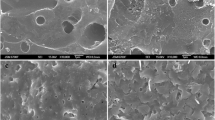Abstract
Results are presented of studies on the structure and properties of nanocomposite materials (NCM) based on nanoporous carbon (NPC) and thermally exfoliated graphite (TEG). NCM is promising as electrode material for supercapacitors (SC) with a double electric layer. NPC was obtained from a phytogenic raw material using hydrothermal carbonization. TEG was produced from oxidized natural graphite by thermal exfoliation. A JSM-6490LV (JEOL Ltd., Japan) electron microscope was used to study the samples’ microstructure. A Quantachrome Autosorb instrument was used to study nitrogen adsorption/desorption isotherms and analyse porous structure. The multipoint Brunauer–Emmett–Teller (BET) method was used to determine the specific surface area of electrodes. The electrochemical properties of the samples were analyzed using the methods of galvanostatic cycling and electrochemical impedance spectroscopy employing an AUTOLAB PGSTAT12 (ECO CHEMIE, the Netherlands) measuring instrument. Our study shows that the employment of TEG in this NCM reduces the internal resistance of supercapacitors (SC), and this increases their specific capacitance. The results of electrochemical studies show that the capacitance of SCs based on the noted NCMs amounts to 155–160 F/g. An equivalent circuit is proposed, allowing the simulation of impedance spectra in the frequency range of 10−3–105 Hz. A physical interpretation of each element of the electric circuit is presented.
Similar content being viewed by others
References
Conway, B.E., Electrochemical Supercapacitors. Scientific Fundamentals and Technological Applications, New York: Kluwer Academic Plenum Publ., 1999.
Frackowiak, E. and Béguin F., Carbon materials for the electrochemical storage of energy in capacitors, Carbon, 2001, vol. 39, no. 6, pp. 937–950.
Inagaki, M., Hidetaka Konno, H., and Osamu Tanaike, O., Carbon materials for electrochemical capacitors, J. Power Sources, 2010, vol. 195, pp. 7880–7903.
Lozano-Castellóa, D., Cazorla-Amorósa, D., and Linares-Solano, A., Influence of pore structure and surface chemistry on electric double layer capacitance in non-aqueous electrolyte, Carbon, 2003, vol. 41, no. 9, pp. 1765–1775.
Pandolfo, A.G. and Hollenkamp, A.F., Carbon properties and their role in supercapacitors, J. Power Sources, 2006, vol. 157, pp. 11–27.
Zheng, J.P., Huang, J., and Jow, T.R., The limitations of energy density for electrochemical capacitors, J. Electrochem. Soc., 1997, vol. 144, no. 6, pp. 2026–2031.
Salitra, G., Soffer, A., and Eliad L., Carbon electrodes for double-layer capacitors. I. Relations between ion and pore dimensions, J. Electrochem. Soc,, 2000, vol. 147, no. 7, pp. 2486–2493.
Radeke, K.H., Backhaus, K.O., and Swiatkowski, A., Electrical conductivity of activated carbons, Carbon, 1991, vol. 29, no. 1, pp. 122–123.
Budzulyak, I.M., Mandzyuk, V.I., and Lisovs’kii R.P., Electrochemical characteristics of capacitor systems based on a chemically modified carbon, Nanosyst. Nanomater. Nanotekh., 2006, vol. 4, no. 2, pp. 569–583.
Ostafiichuk, B.K., Budzulyak, I.M., and Rachiy, B.I., Influence of chemical treatment on the properties of activated carbon materials, Fiz. Khim. Tverd. Tila, 2008, vol. 9, no. 3, pp. 609–612.
Budzulyak, I.M., Grigorchak, I.I., Mironyuk, I.F., and Ostafiichuk, B.K., Ukranian Patent 45576 A, Byull., 2002, no. 4.
Chernysh, I.G., Nikitin, Yu.O., Chernysh, S.I., and Loboda, P.I., On the influence of dispergation methods on the microstructure and morphology of dispersed particles of natural graphite and thermographenite, Nauk. Visti NTUU “KPI”, 2008, no. 1, pp. 76–80.
Rachiy, B.I., Morphology and electrochemical properties of thermally modified nanoporous carbon, Extended Abstract of Cand. Sci. (Phys.-Math.) Dissertation, Ivano-Frankivs’k, 2010.
Gregg, S.J, and Singh K.S.W., Adsorption, Surface Area and Porosity, London: Academic Press, 1982.
Revo, S.L., Budzulyak, M.I., Rachiy, B.I., and Kuzishin, M.M., Electrode material for supercapacitors based on nanostructured carbon, Surf. Eng. Appl. Electrochem., 2013, vol. 49, no. 1, pp. 68–72. doi 10.3103/S1068375513010122
Revo, S.L., Lozovii, F.V., Ivanenko, K.O., and Avramenko, T.G., Influence of the formation conditions of polymer–carbon composite mixtures on their resistance, Fiz. Khim. Tverd. Tila, 2010, vol. 11, no. 4, pp. 1029–1033.
Bukharov, V.A., New electrode materials for supercapacitors, Nauk. Visn. Uzhgorod. Univ. Ser. Fiz., 2007, no. 21, pp. 25–28.
Sing, K.S.W., Everett, D.H., Haul, R.A.W., Moscou, L., Pierotti, R.A., Rouquerol, J., and Siemieniewska T., Reporting phisorption data for gas/solid systems, Pure Appl. Chem., 1985, vol. 57, no. 4, 603–619.
Kovalyuk, Z.D., Bodnarashek, V.M., Mikityuk, I.P., Yurtsenyuk, N.S., and Yurtsenyuk, S.P., Electrode component for supercapacitors–porous carbon material from an organic raw material of vegetal origin, Fiz. Inzh. Pov., 2011, vol. 9, no. 2, pp. 176–181.
Bakhmatyuk, B.P., Kurepa, A.S., and Grigorchak, I.I., Impedance spectroscopy of supercapacitors based on a nanoporous activated carbon material, Visn. Nats. Univ. “L’viv. Politekhn.” Fiz.-Mat. Nauki, 2010, vol. 687, pp. 188–193.
Author information
Authors and Affiliations
Corresponding author
Additional information
Original Russian Text © B.I. Rachiy, I.M. Budzulyak, E.A. Ivanenko, S.L. Revo, 2015, published in Elektronnaya Obrabotka Materialov, 2015, No. 5, pp. 90–98.
About this article
Cite this article
Rachiy, B.I., Budzulyak, I.M., Ivanenko, E.A. et al. A composite of nanoporous carbon and thermally exfoliated graphite as an effective electrode material for supercapacitors. Surf. Engin. Appl.Electrochem. 51, 501–508 (2015). https://doi.org/10.3103/S1068375515050129
Received:
Accepted:
Published:
Issue Date:
DOI: https://doi.org/10.3103/S1068375515050129




